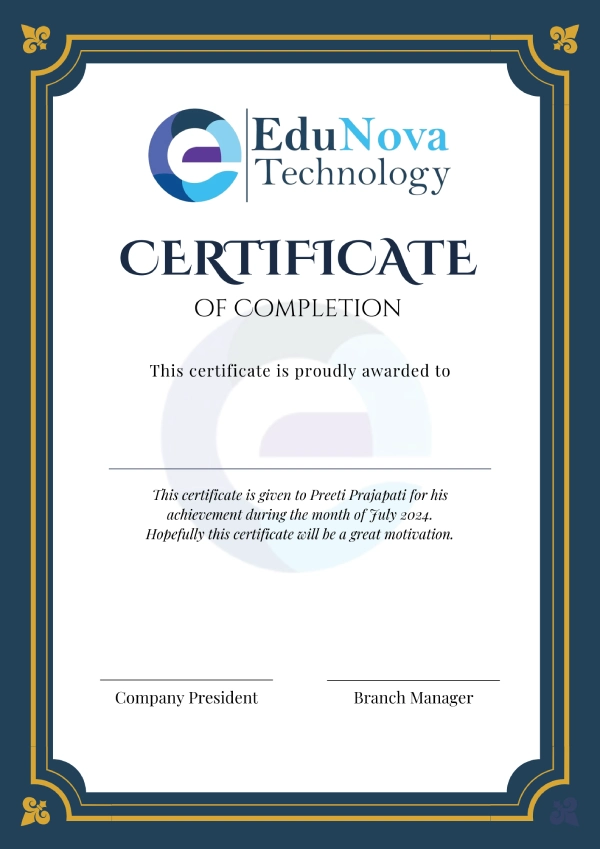- Overview of Web Design vs. Web Development
- Introduction to Web Development Tools (IDEs, Text Editors, Web Browsers)
- Understanding Web Servers and Clients
- Basic Web Technologies: HTML, CSS, JavaScript
- Introduction to Front-End vs. Back-End Development
Web Technologies
Web Development
Have you ever thought of creating Web Development?
Based on 99 Reviews
- Duration : 1 Month / 3 Months / 6 Months
- Language: English
- Certificate of Completion

A Web Development Course provides a complete learning pathway to master the art of building dynamic and functional websites. Covering both front-end and back-end development, this course includes essential technologies like HTML, CSS, JavaScript, and frameworks such as React or Angular for front-end, alongside Node.js, PHP, or Python for back-end development. Participants gain expertise in database management, API integration, and version control systems like Git. Through hands-on projects, learners build real-world applications, focusing on performance, security, and scalability. Whether you’re a beginner or enhancing your skills, this course prepares you for a rewarding career in web development or freelance opportunities.
- What is HTML?
- Structure of an HTML document
- HTML tags and elements
- Attributes in HTML
- Introduction to the DOCTYPE declaration
- Comments in HTML
- Basic HTML tags (head, body, title, meta)
- Formatting text: <h1>, <p>, <strong>, <em>, <br>, etc.
- Lists: Ordered, Unordered, and Definition lists
- Links and anchor tags (<a>)
- Images and multimedia elements (<img>, <audio>, <video>)
- Tables and their structure (<table>, <tr>, <td>, <th>)
- Forms and input elements (<form>, <input>, <button>, <select>, <textarea>)
- Semantic HTML tags: <header>, <footer>, <article>, <section>, <nav>, etc.
- HTML5 features (local storage, canvas, audio, video)
- HTML forms with validation attributes
- HTML attributes for accessibility (aria-labels, alt attributes)
- Responsive meta tags
- Creating links to anchor points within the page
- What is CSS?
- Inline, internal, and external CSS
- CSS selectors and properties
- How CSS applies to HTML (cascade and specificity)
- Linking CSS to HTML
- The Box Model Concept
- Margins, borders, padding, and content
- Width, height, and display properties
- Understanding box-sizing and overflow properties
- Positioning and positioning properties (static, relative, absolute, fixed)
- Font properties: font-family, font-size, font-weight, line-height, letter-spacing
- Text alignment, color, decoration, and transformation
- Text shadow and word spacing
- CSS color values (hex, rgb, rgba, hsl)
- Background properties: background-color, background-image, background-repeat
- Linear and radial gradients in CSS
- Block vs inline elements
- CSS Flexbox: concepts and usage
- CSS Grid Layout: grid containers, grid items, grid-template, grid-gap
- Floats and clearfix
- Creating multi-column layouts with
- Flexbox and Grid
- CSS transition properties and effects
- Using :hover for interactive styling
- Creating keyframe animations
- Animating elements with @keyframes
- Practical examples of animations (e.g., buttons, navigation, modals)
- What is responsive design?
- Introduction to media queries
- Designing for different screen sizes (mobile, tablet, desktop)
- Fluid grids, flexible images, and relative units
- Mobile-first design principles
- Understanding container, row, and column classes
- Creating responsive layouts with the grid system
- Offsetting and ordering columns
- Nesting columns in Bootstrap
- Creating navigation bars with Bootstrap
- Buttons and button groups
- Forms and form controls
- Cards for content display
- Alerts and modals for notifications
- Dropdowns, carousels, and spinners
- Progress bars and tooltips
- Customizing Bootstrap using Sass variables
- Modifying colors, fonts, and components
- Overriding Bootstrap’s default styles
- Creating custom themes using Bootstrap
- Design consistency and visual hierarchy
- Importance of white space in design
- Typography best practices
- Color theory and contrast for readability
- Mobile-first and cross-browser compatibility
- What is JavaScript and Why It’s Important
- How JavaScript is Integrated into Web Pages
- Understanding the DOM (Document Object Model)
- Variables, Data Types, and Operators
- Conditionals: if, else, switch
- Loops: for, while, do-while
- Functions: Declaration, Expressions, and Arrow Functions
- Event Handling in JavaScript (click, submit, hover)
- Understanding Scope: Global vs. Local
- Selecting Elements with getElementById, querySelector, querySelectorAll
- Modifying HTML
- Content and Attributes: innerHTML, textContent, setAttribute
- Changing CSS Properties Dynamically with JavaScript
- Handling Events: click, change, submit, keypress
- Event Listeners and Event Delegation
- Creating and Removing Elements Dynamically
- Introduction to
- Asynchronous Programming
- Callbacks and Callback Hell
- Promises and Promise Chaining
- Using async and await for Asynchronous Code
- Client-Side Validation Using JavaScript
- Validating Text Input, Email, and Password Fields
- Using Regular Expressions for Validation
- Displaying Error Messages Dynamically
- What is jQuery and
- Why Use It?
- Integrating jQuery into Web Pages (CDN vs. Local Files)
- Basic Syntax of jQuery: Selectors, Methods, and Events
- jQuery Functions: $(), .css(), .html(), .text()
- Selecting Elements Using jQuery Selectors
- Modifying HTML Content and Attributes with jQuery
- Traversing DOM: .parent(), .children(), .siblings()
- Adding and Removing Elements Dynamically
- Chaining jQuery Methods for Efficient Code
- Handling Events: .click(), .hover(), .on()
- Event Delegation with jQuery
- Animations and Effects: .show(), .hide(), .fadeIn(), .fadeOut(), .slideUp(), .slideDown()
- Introduction to AJAX with jQuery
- Sending Data to the Server Using $.ajax()
- Handling JSON Data with jQuery
- Making GET and POST Requests
- Using AJAX to Fetch Data Dynamically and Update the UI
- Project 1: Personal Portfolio Website
- Project 2: Interactive Product Landing Page
- Project 3: To-Do List Application
- Project 4: Blog Website
This Course Include
- Language: English
- Duration : 1 Month / 3 Months / 6 Months
- Learning Mode: At Center ( Only Offline Classes )
- Jurisdiction: Nationwide
- Certificate of Completion
Eligibility Criteria
- Learner should preferably a std. 10th Pass student (Not Compulsory)
- It is desirable that Learner should have done MS-CIT Course (Not Compulsory)
Premium Course
Register For This Course
About Ms. Anjali Arora
Enroll in EduNova’s Flutter App Development Course and master the art of building stunning, high-performance mobile apps for both iOS and Android. Our expert instructors will walk you through each step of the development process, from installation and setup to debugging and deployment. You’ll gain essential programming skills, including Dart fundamentals, such as `const`, `static`, and `final` keywords, as well as Object-Oriented Programming (OOP) in Dart.
Based on 99 Reviews
Ready to take your team to the next level?
Contact us today to learn more about our Corporate Training programs and discover how we can help your organization thrive.


- IITM Pravartak certified Python certification.
- Certificates are globally recognized & they upgrade your programming profile.
- Certificates are generated after the completion of course.














Students/ Job Seekers

Business
Owners

Influencers/ Youtubers

Work as Freelancers

Working Professionals

Women / Housewives
They are unique because of their unique approach i.e; Placement, training then Hike. Firstly, they get students placed then give 8 Months of training in any Certification of your choice and at least a 70% hike after 10 months.
Click on Side menu- Choose Courses- Select the course you want to see- Course Detail page will open- click on Start Learning on top- now you can Enrol for the course.
Yes. We offer certifications upon course completion.
Python
Data science
Artificial Intelligence
Digital marketing
Cyber Security
Data Analytics
Quantum computing/ Cloud computing
Android App development
Web development


